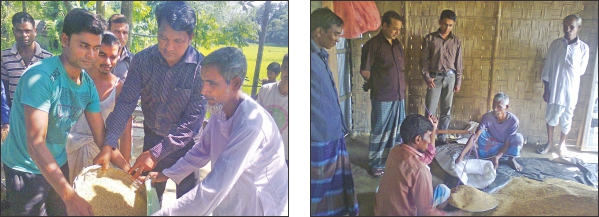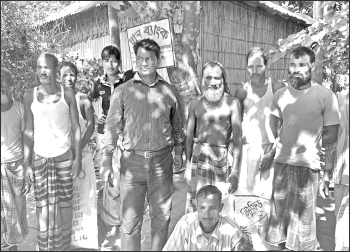Feature 1
Lalmonirhat
Rice Bank:
Hope for the Monga Hit
They have no cash, so they don't go to any commercial bank. They live hand-to-mouth and face monga (times of fewer available job opportunities for rural workers) several times round the year. Once they had to face difficulty during their monga period and borrowed money from local money lenders with high interest rate to overcome the crisis. But, many of them are now overcoming monga without taking any loan. They are building rice banks – with most important asset, rice.
...............................................................................................................
S Dilip Roy
 Extremely poor people of different monga prone areas at Teesta and Dharla river basin of five upazilas in Lalmonirhat district deposit their produced rice in the rice bank during the monsoon period and they get it back during their bad times locally called monga period. Extremely poor people of different monga prone areas at Teesta and Dharla river basin of five upazilas in Lalmonirhat district deposit their produced rice in the rice bank during the monsoon period and they get it back during their bad times locally called monga period.
The general concept of rice bank is to make rice available for extreme-poor households during lean and disaster period. A total of 10-20 poor households in a community who are suffering from food insecurity will from and own this rice bank. RDRS provides rice to this rice bank for one time as grant, where the member will borrow rice from this rice bank during lean period and return rice to their rice bank during harvesting period, so they can borrow rice again during monga. It helps the particular household family members not to go hungry during lean period. The members have absolute ownership of this bank and its rice with the condition that they have to return the equal amount of rice (with some extra like 5 kg per 50 kg for maintenance and weight loss) during next harvesting period.
A member, Abu Bakkor Siddique at Purbo Boruya village in Lalmonirhat sadar upazila said, that they built a rice bank in the village with 25 members who are identified as ultra-poor people. “We the members of the rice bank deposit rice during the monsoon period and we take it during our bad times. The rice bank in our village has been playing an important role in the last two years,” he said.
Milon Bshwa, another poor farmer of the village said “before we had to take loan money from local money lenders with high interest rate. Because of the rice bank, we no longer need to lend money” he said.
Rubol Chandro Roy another member of Tajpur village rice bank said, “I and all 25 members of the rice bank getting output. We deposit 64 Kgs rice in the rice bank during the harvesting season and we get 70 Kgs rice during the monga period. The members of the rice bank are increasing day by day in our village”.
General secretary of Tajpur rice bank, Pran Krishno Chandro Roy said that it is necessary to build rice bank in every village by for the extremely poor people to overcoming their monga crisis.

Lalmonirhat sadar upazila agriculture officer Mohammad Nuruzzaman explained the operation of rice banks. The vulnerable households in the community can from a group to establish and implement rice bank in the community. A total of 10 to 20 vulnerable households may become the members of a rice bank. The members will be the owner of that particular rice bank and they will form one executive committee comprising 2 to 3 members among the general members who will take proper care of this bank and run the bank the right way. The executive committee will select one member, who will store 1-2 ton rice in his/her house. The bank will decide through an agreement which month and date they will borrow rice, and which month and date they will return rice to their bank. A member of the rice bank owners will borrow 50 kg rice and and return 55 kg. The extra 5 kg is to cut cover the maintenance cost and compensate handling and weight loss.
Md. Faisal Ibne Mizan, an Agriculture Officer of NGO RDRS said, the project was initiated the assistance by a local partner RDRS –major funding was done through donation by philanthropic Bangladeshi individuals living aboard.
 The Agriculture and Environment Coordinator of RDRS, Mamunur Rashid said that the purpose of rice bank is to encourage people for savings by enhancing food security the monga period. This protects them from selling assets, selling advance labour, borrowing money from moneylenders with high interest rates, taking paddy from rich people with a condition to return double the amount during next harvesting period. All these cumulatively keep them away from debts and consequently protect them from failing in to the various cycle of monga as well as any disaster during lean period. The Agriculture and Environment Coordinator of RDRS, Mamunur Rashid said that the purpose of rice bank is to encourage people for savings by enhancing food security the monga period. This protects them from selling assets, selling advance labour, borrowing money from moneylenders with high interest rates, taking paddy from rich people with a condition to return double the amount during next harvesting period. All these cumulatively keep them away from debts and consequently protect them from failing in to the various cycle of monga as well as any disaster during lean period.
“The rice bank program in the community can be treated as a sustainable model, as it requires only one time support at the beginning of the program. Any donor can support it by providing paddy at the beginning of the program and then the program will continue year after year. If there is no donor support, the members of this rice bank can store rice in there bank during harvesting period and may be able to maintain it accordingly. After establishment of these rice banks, it requires just only to follow-up the program by the executive committee in order to keep it in the right track,” he said.
The Development Programme Manager of RDRS in Lalmonirhat Ziaul Islam said, through rice bank, rural poor households have gotten access to food in lean period in a sustainable way.
Food security is enhanced among the rice bank member households during lean period for which they are now able to avoid moneylender and also to avoid selling labour in advance with a very low wage. Government of Bangladesh may consider the rice bank concept as an alternative model for its effectivity and sustainability.
Copyright
(R) thedailystar.net 2013 |